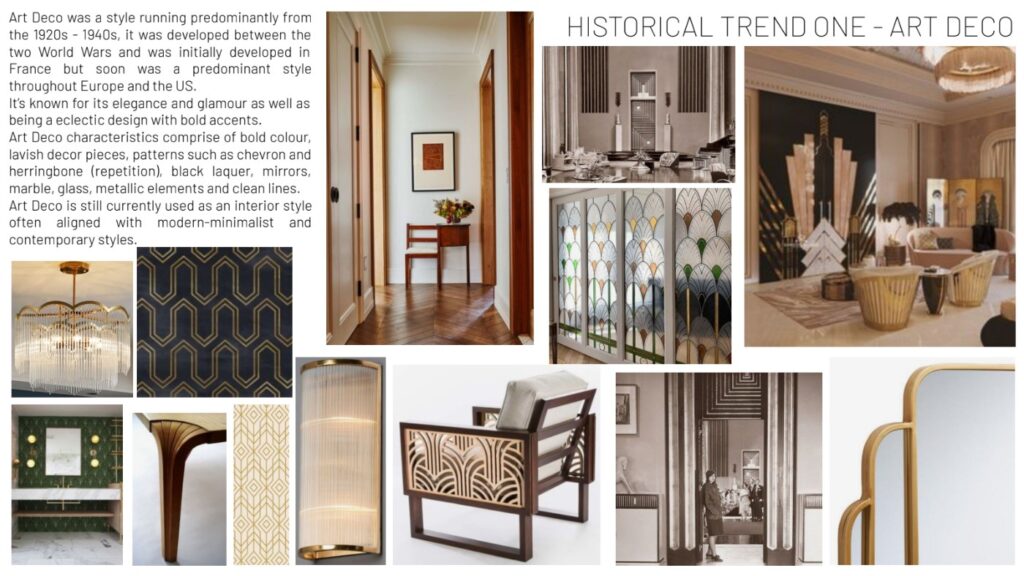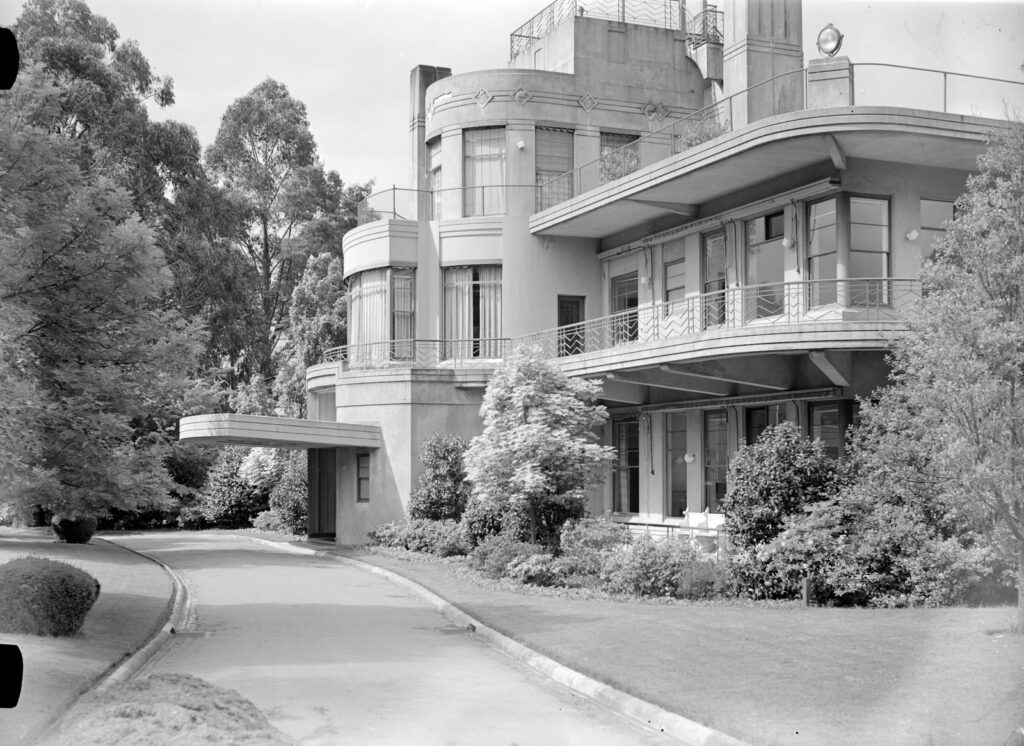What is Art Deco Interior Design?

When Did the Art Deco Interior Design Movement Begin?
In the 1910s, Parisian designers began to fashion a new style that reflected a sleek elegance and the modernity of the changing times. In the interwar period, Art Deco interior design, architecture and art truly flourished throughout Western Europe and the United States.
At the Exposition Internationale des Arts Décoratifs et Industriels Modernes, held in Paris in 1925, the Art Deco movement was given its name.
What Makes Art Deco Interior Design Unique?
Art Deco interior design is characterised by stylised, geometric lines and a blend of luxury materials (metallic embellishments, rich timbers, ivory) with new, industrial materials and shapes made possible by contemporary machinery and materials such as Bakelite plastic.

ISCD student work by Madeleine Hart.
Some of the natural motifs of the preceding Art Nouveau style carried over into Art Deco design, but the flowers and vines became streamlined, with geometric, stylised versions adorning stained glass, textiles and metalwork.
Art Deco interior design ranged from the opulent, to the clean simplicity of Streamline Moderne.

The Avalon Theatre, California. Photo by Laurel and Michael Evans on Unsplash.
Formative influences included Art Nouveau, the Bauhaus, Cubism, and Serge Diaghilev’s Ballets Russes. Decorative ideas came from Indigenous American, Egyptian, and early classical sources as well as from nature.
Patterns such as chevron and herringbone were popular. Characteristic motifs included neoclassical sculptures and prints, animals, foliage, and sun rays.
The Roaring Twenties and Beyond
The style has gone through many iterations, and although French designers remained hugely influential, other influences transformed the Art Deco movement with time.
As travel to Africa and the Middle East was a popular pastime for the wealthy, and archeology captured the public imagination, the influence of Egyptian architecture and African prints became part of the style.

Close-up of the Chrysler Building, New York. Photo by William Wachter on Unsplash.
In the 1960s revival of the Art Deco style, many existing examples of Art Deco architecture were given revitalised interiors, while the streamlined, understated elegance (rather than the outright opulence of the style) made its way into everyday home designs. The style also blended well with the equally sharp lines and bold colours of the Pop Art and Postmodern designs that were emerging.
Art Deco Architecture
The Chrysler Building was the tallest skyscraper in the world when it was built in 1930s New York, and its Art Deco silhouette remains distinctive to this day.
In contrast to the imposing industrial splendour of the Chrysler Building, the Hôtel Martinez in Cannes is an example of the breezy, yet luxurious Art Deco architecture that would become popular in seaside resorts.

Hôtel Martinez, Cannes.
Around the world, cinemas and theatres remain as enduring monuments to the Art Deco style, and some beautiful examples remain in the Metro/Minerva Theatre in Potts Point, New South Wales, the Capitol Theatre in Melbourne, Victoria and the Regal Theatre in Subiaco, Western Australia.

The Capitol Theatre auditorium, designed by Walter Burley Griffin. Photograph by Lyle Fowler.
Throughout Australia, other examples of Art Deco architecture survive, from humble family homes to grand commercial structures, such as the Manchester Unity Building in Melbourne.
Is the Art Deco Style Still Relevant for Interior Designers and Decorators Today?
At ISCD, we teach design history and cover a range of styles in our courses. Students in our Design Practice short course microcredential, Certificate IV in Interior Decoration or Diploma of Interior Design will cover the fundamentals of interior and architectural styles such as Art Deco. This allows them to both grow their design knowledge and to help them apply sympathetic interior decoration to a range of building styles.

Burnham Beeches, Sherbrooke, Victoria. Photograph from the State Library of Victoria.
Madeleine Hart is an ISCD student and is studying the history and modern applications of Art Deco design.
“Art Deco is still currently used as an interior style often aligned with modern-minimalist and contemporary styles.”
“It’s known for its elegance and glamour as well as being an eclectic design with bold accents. Art Deco characteristics comprise of bold colour, lavish decor pieces, patterns such as chevron and herringbone (repetition), black lacquer, mirrors, marble, glass, metallic elements and clean lines.”

ISCD student work by Madeleine Hart.
Many existing Art Deco buildings will call for an interior designer who can bring their understanding of the original style to a refreshed and modern design.
There are also instances where the Art Deco style will be used as the predominant influence on a new space. Each time the era appears on screen, such as in The Great Gatsby or a new Agatha Christie adaptation, we seem to collectively start dreaming of 1920s parties and the golden age of The Orient Express.
Bringing Art Deco Style into Modern Homes
Sean Wong is an ISCD alumni who wanted to explore ways to renovate an apartment in an original Art Deco building. Sean trod the delicate line of remaining faithful to the style while ensuring it met the needs of modern living, and you can see the results in his student work here.
“The Art Deco Era not only celebrated bold geometric forms and bright colours; and indulged in expensive materials with exquisite craftsmanship, its sleek and sophisticated aesthetic was also a celebration of the machine age.”

ISCD student work by Sean Wong.
“The elevators of the era are a perfect representation of the sum of all these elements.
“I was inspired by these elevators but wanted to bring the opulence to a more contemporary lightness that suited the rest of this renovated Art Deco home. There is a sense of elegance with a light airiness, to the space.”

ISCD student work by Sean Wong.
The golden age of Art Deco interior design may be over, but with many significant buildings now protected by heritage status, and a collective enthusiasm for the era that waxes and wanes but never seems to die, it’s safe to say that Art Deco design will continue to remain a recognised and well-loved style for the ages.